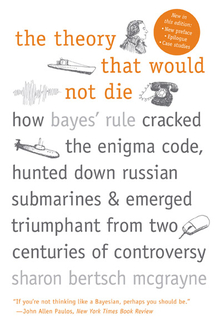Sharon Bertsch McGrayne - The Theory That Would Not Die
Sharon Bertsch McGrayne 2011. The Theory That Would Not Die. How Bayes’ Rule Cracked the Enigma Code, Hunted Down Russian Submarines, and Emerged Triumphant from Two Centuries of Controversy. New Haven: Yale University Press, 320 pp.
 First read this in Feb 2012. Re-reading reinforces first impression: clear simple explanations, very thoroughly researched by a journalist at the top of her game. For good reason this seems to be the introduction to Bayesian reasoning most frequently recommended by statisticians.
First read this in Feb 2012. Re-reading reinforces first impression: clear simple explanations, very thoroughly researched by a journalist at the top of her game. For good reason this seems to be the introduction to Bayesian reasoning most frequently recommended by statisticians.
The short first chapter on the Reverend Thomas Bayes and his ball-tossing system for updating initial beliefs is a clear intuitively understood explanation of Bayesian thinking in simple form 1763. However the following chapter, on Pierre Simon Laplace, stands out. Not just because Laplace has a seminal role in developing the mathematics of probability theory and in particular developing Bayes’ idea (which he became aware of in 1781), but because of Laplace’s contributions in astronomy, demographics, establishing the central limit theorem, almost pioneering the new job description of professional scientist, his deft survival during the French Revolution, among other achievements.
The chapter on the role of Alan Turing and Bayesian probability in the Enigma story is, I think, the best short summary of that singular, unforgettable history, triumphant drama and personal tragedy. Most of the rest of the book is on various applications, all fluently and often thrillingly told examples of inverse probability: probability of mid-air collisions of passenger planes, of nuclear accidents, of lung and breast cancer, finding missing submarines.
Extensively referenced, although it is a pity that the endnote/bibliography method means that finding a full reference after the first citation requires thumbing back laboriously since all subsequent citations are abbreviated. All to save a ha’penny-worth of paper. A mountain of further reading here…


